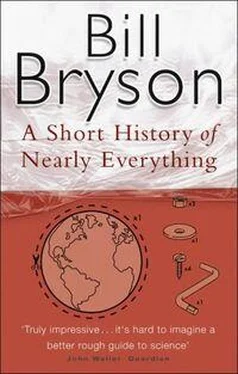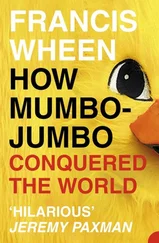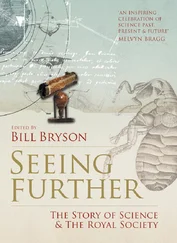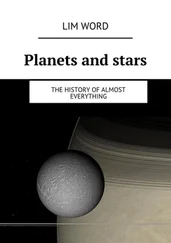It all happened remarkably quickly. To grow from a tiny cluster of grains to a baby planet some hundreds of miles across is thought to have taken only a few tens of thousands of years. In just 200 million years, possibly less, the Earth was essentially formed, though still molten and subject to constant bombardment from all the debris that remained floating about.
At this point, about 4.5 billion years ago, an object the size of Mars crashed into Earth, blowing out enough material to form a companion sphere, the Moon. Within weeks, it is thought, the flung material had reassembled itself into a single clump, and within a year it had formed into the spherical rock that companions us yet. Most of the lunar material, it is thought, came from the Earth’s crust, not its core, which is why the Moon has so little iron while we have a lot. The theory, incidentally, is almost always presented as a recent one, but in fact it was first proposed in the 1940s by Reginald Daly of Harvard. The only recent thing about it is people paying any attention to it.
When Earth was only about a third of its eventual size, it was probably already beginning to form an atmosphere, mostly of carbon dioxide, nitrogen, methane, and sulfur. Hardly the sort of stuff that we would associate with life, and yet from this noxious stew life formed. Carbon dioxide is a powerful greenhouse gas. This was a good thing because the Sun was significantly dimmer back then. Had we not had the benefit of a greenhouse effect, the Earth might well have frozen over permanently, and life might never have gotten a toehold. But somehow life did.
For the next 500 million years the young Earth continued to be pelted relentlessly by comets, meteorites, and other galactic debris, which brought water to fill the oceans and the components necessary for the successful formation of life. It was a singularly hostile environment and yet somehow life got going. Some tiny bag of chemicals twitched and became animate. We were on our way.
Four billion years later people began to wonder how it had all happened. And it is there that our story next takes us.
PART II THE SIZE OF THE EARTH
Nature and Nature's laws lay hid in night; God said, Let Newton be! and all was light.
Alexander Pope
IF YOU HAD to select the least convivial scientific field trip of all time, you could certainly do worse than the French Royal Academy of Sciences’ Peruvian expedition of 1735. Led by a hydrologist named Pierre Bouguer and a soldier-mathematician named Charles Marie de La Condamine, it was a party of scientists and adventurers who traveled to Peru with the purpose of triangulating distances through the Andes.
At the time people had lately become infected with a powerful desire to understand the Earth-to determine how old it was, and how massive, where it hung in space, and how it had come to be. The French party’s goal was to help settle the question of the circumference of the planet by measuring the length of one degree of meridian (or 1/360 of the distance around the planet) along a line reaching from Yarouqui, near Quito, to just beyond Cuenca in what is now Ecuador, a distance of about two hundred miles. [3]
Almost at once things began to go wrong, sometimes spectacularly so. In Quito, the visitors somehow provoked the locals and were chased out of town by a mob armed with stones. Soon after, the expedition’s doctor was murdered in a misunderstanding over a woman. The botanist became deranged. Others died of fevers and falls. The third most senior member of the party, a man named Pierre Godin, ran off with a thirteen-year-old girl and could not be induced to return.
At one point the group had to suspend work for eight months while La Condamine rode off to Lima to sort out a problem with their permits. Eventually he and Bouguer stopped speaking and refused to work together. Everywhere the dwindling party went it was met with the deepest suspicions from officials who found it difficult to believe that a group of French scientists would travel halfway around the world to measure the world. That made no sense at all. Two and a half centuries later it still seems a reasonable question. Why didn’t the French make their measurements in France and save themselves all the bother and discomfort of their Andean adventure?
The answer lies partly with the fact that eighteenth-century scientists, the French in particular, seldom did things simply if an absurdly demanding alternative was available, and partly with a practical problem that had first arisen with the English astronomer Edmond Halley many years before-long before Bouguer and La Condamine dreamed of going to South America, much less had a reason for doing so.
Halley was an exceptional figure. In the course of a long and productive career, he was a sea captain, a cartographer, a professor of geometry at the University of Oxford, deputy controller of the Royal Mint, astronomer royal, and inventor of the deep-sea diving bell. He wrote authoritatively on magnetism, tides, and the motions of the planets, and fondly on the effects of opium. He invented the weather map and actuarial table, proposed methods for working out the age of the Earth and its distance from the Sun, even devised a practical method for keeping fish fresh out of season. The one thing he didn’t do, interestingly enough, was discover the comet that bears his name. He merely recognized that the comet he saw in 1682 was the same one that had been seen by others in 1456, 1531, and 1607. It didn’t become Halley’s comet until 1758, some sixteen years after his death.
For all his achievements, however, Halley’s greatest contribution to human knowledge may simply have been to take part in a modest scientific wager with two other worthies of his day: Robert Hooke, who is perhaps best remembered now as the first person to describe a cell, and the great and stately Sir Christopher Wren, who was actually an astronomer first and architect second, though that is not often generally remembered now. In 1683, Halley, Hooke, and Wren were dining in London when the conversation turned to the motions of celestial objects. It was known that planets were inclined to orbit in a particular kind of oval known as an ellipse-“a very specific and precise curve,” to quote Richard Feynman-but it wasn’t understood why. Wren generously offered a prize worth forty shillings (equivalent to a couple of weeks’ pay) to whichever of the men could provide a solution.
Hooke, who was well known for taking credit for ideas that weren’t necessarily his own, claimed that he had solved the problem already but declined now to share it on the interesting and inventive grounds that it would rob others of the satisfaction of discovering the answer for themselves. He would instead “conceal it for some time, that others might know how to value it.” If he thought any more on the matter, he left no evidence of it. Halley, however, became consumed with finding the answer, to the point that the following year he traveled to Cambridge and boldly called upon the university’s Lucasian Professor of Mathematics, Isaac Newton, in the hope that he could help.
Newton was a decidedly odd figure-brilliant beyond measure, but solitary, joyless, prickly to the point of paranoia, famously distracted (upon swinging his feet out of bed in the morning he would reportedly sometimes sit for hours, immobilized by the sudden rush of thoughts to his head), and capable of the most riveting strangeness. He built his own laboratory, the first at Cambridge, but then engaged in the most bizarre experiments. Once he inserted a bodkin-a long needle of the sort used for sewing leather-into his eye socket and rubbed it around “betwixt my eye and the bone as near to [the] backside of my eye as I could” just to see what would happen. What happened, miraculously, was nothing-at least nothing lasting. On another occasion, he stared at the Sun for as long as he could bear, to determine what effect it would have upon his vision. Again he escaped lasting damage, though he had to spend some days in a darkened room before his eyes forgave him.
Читать дальше












